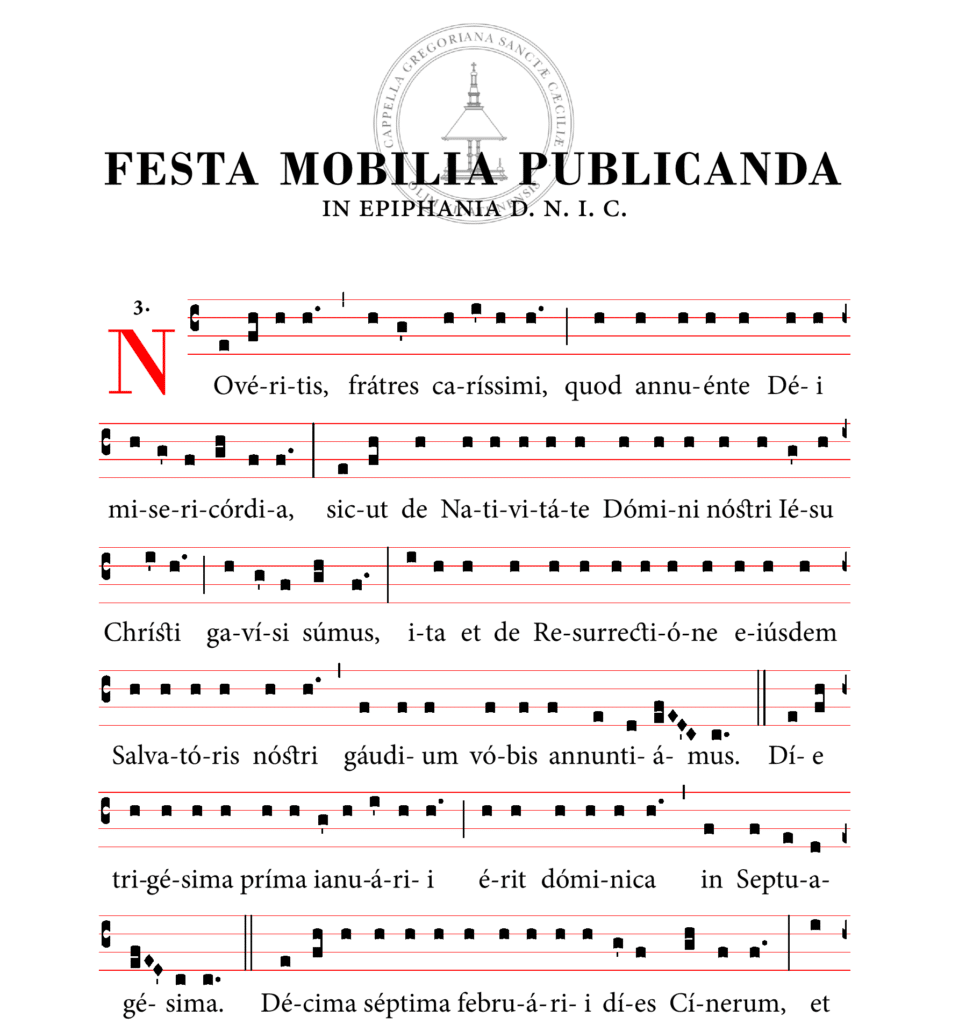Enter the Theophanic Matrix: Your Guide to Moveable Catholic Feasts

There is a tradition dating back to the Council of Nicea in the 4th century to proclaim the dates of the movable feasts at the Feast of the Epiphany. This was referred to as the Theophanic Announcement. The Theo…whatsis??!
Theophanic Definition
Theophany pertains to the the appearance or manifestation of God to humanity. Therefore, the Theophanic Announcement proclaims the feasts that commemorate God manifesting Himself to humanity, from Advent to Ascension.
The Noveritis, The Theophanic Chant
The musical chant setting for this, called the Noveritis, is a beautiful way to elevate the importance of the Epiphany. This was historically sung after the Gospel and was intended to closely resemble the Exsultent Chant of the Easter Vigil Liturgy. This seems quite logical and appropriately actually, as you consider that the Feast of the Nativity of Jesus and the Epiphany are the two fixed feasts that we have just celebrated in the new liturgical year and now the remaining major feasts are tied to Easter and therefore are moveable.
While considered an ancient tradition, you will find the equivalent Epiphany Proclamation done in the vernacular in some Novus Ordo parishes as it remains part of the current Roman Missal.
The Determination of the Easter Date
The date of Easter was originally defined by the Council of Nicaea in 325 A.D as:
“the Sunday following the fourteenth day of the Moon reaching this age on March 21 or immediately after”.
This has been translated more simply as Easter is the first Sunday following the first full Moon of Spring. This second definition is misleading however, because it suggests that the date of Easter is the result of astronomical calculation based on the determination of the Spring equinox and of the first full moon after the equinox. Actually, though, the calculation of the date of Easter is done by algorithm using a fictitious average Moon (known as the “Ecclesiastical Moon” ). This mysterious and complex algorithm is known as the Computus, which correlates the lunar cycle and the solar year.
Nowadays, we take the determination of the dates of Easter and all the ensuing dates for granted based on various published sources that are easy to find on the internet, such as right here :). However, in the early Church, it wasn’t so simple. The world’s greatest astronomers were tasked with advising the Pontiff of the date of the first full moon of spring. This date was then used in the determination of the date of Easter and all the associated movable feasts dependent on that date. People would then receive these dates during Mass and write them down or memorize them for future reference.
This proclamation begins with the next most notable date following Epiphany on our liturgical calendar, Septuagisma Sunday, the beginning of the Traditional season of Lent. Given the range of possibilities, on average, Septuagisma falls on about February 5. That seems about right, falling just past the the exact halfway point between the Winter Solstice of December 21 and the Spring Equinox of March 21. And what would you know, on the year of this article’s publishing (2023), Septuagesima falls on Feburary 5! So if you are reading this in 2023, quite an “average year,” this is a good time to introduce you into the simulation!
The concept of life as a simulation has entered popular culture and parlance, particularly with the movies such as The Matrix. The Liturgical Year can be understood in terms of simulations, as there are many different date combinations and only rarely would one experience the same Liturgical Year in one life time. This is based on the variation of dates between the earliest and last dates of Easter (a range of 35 days) combined with the once every four years shift of dates due to Leap Year. Remember the Computus mentioned above? That’s the computing core of the matrix!
The most common dates for Easter are March 31 and April 16 but with the average date in the range being April 8. However, strangely it is very rare for Easter to fall on April 8, having recently happened in 2007 and 2012 but not scheduled to occur again until 2091! If you are reading this in 2023, you will note this a very “nearly average” simulation with Easter falling on April 9.
The Road to Bethlehem: Daily Meditations for Advent and Christmas
The Theophanic Matrix
While there are a myriad of sources on the internet to identify the future starting dates of Lent and Easter, I could find no comprehensive Traditional reference to the dates of all the moveable feasts. Thus, the idea for the Theophanic Matrix was born, summarized below:
| Leap Year | Year | Septua. | Ash Wed. | Good Friday | Easter | Ascension | Pentecost | Corpus Christi | Advent | Notes |
|---|---|---|---|---|---|---|---|---|---|---|
| x | 2020 | 2/9/2020 | 2/26/2020 | 4/10/2020 | 4/12/2020 | 5/21/2020 | 5/31/2020 | 6/11/2020 | 11/29/2020 | |
| 2021 | 1/31/2021 | 2/17/2021 | 4/2/2021 | 4/4/2021 | 5/13/2021 | 5/23/2021 | 6/3/2021 | 11/28/2021 | ||
| 2022 | 2/13/2022 | 3/2/2022 | 4/15/2022 | 4/17/2022 | 5/26/2022 | 6/5/2022 | 6/16/2022 | 11/27/2022 | ||
| 2023 | 2/5/2023 | 2/22/2023 | 4/7/2023 | 4/9/2023 | 5/18/2023 | 5/28/2023 | 6/8/2023 | 12/3/2023 | ||
| x | 2024 | 1/28/2024 | 2/14/2024 | 3/29/2024 | 3/31/2024 | 5/9/2024 | 5/19/2024 | 5/30/2024 | 12/1/2023 | Penetential Valentines Day |
| 2025 | 2/16/2025 | 3/5/2025 | 4/18/2025 | 4/20/2025 | 5/29/2025 | 6/8/2025 | 6/19/2025 | 11/30/2025 | ||
| 2026 | 2/1/2026 | 2/18/2026 | 4/3/2026 | 4/5/2026 | 5/14/2026 | 5/24/2026 | 6/4/2026 | 11/29/2026 | ||
| 2027 | 1/24/2027 | 2/10/2027 | 3/26/2027 | 3/28/2027 | 5/6/2027 | 5/16/2027 | 5/27/2027 | 11/28/2027 | ||
| x | 2028 | 2/13/2028 | 3/1/2028 | 4/14/2028 | 4/16/2028 | 5/25/2028 | 6/4/2028 | 6/15/2028 | 12/3/2028 | |
| 2029 | 1/28/2029 | 2/14/2029 | 3/30/2029 | 4/1/2029 | 5/10/2029 | 5/20/2029 | 5/31/2029 | 12/2/2029 | April Fools Easter | |
| 2030 | 2/17/2030 | 3/6/2030 | 4/19/2030 | 4/21/2030 | 5/30/2030 | 6/9/2030 | 6/20/2030 | 12/1/2030 | ||
| 2031 | 2/9/2031 | 2/26/2031 | 4/11/2031 | 4/13/2031 | 5/22/2031 | 6/1/2031 | 6/12/2031 | 11/30/2031 | ||
| x | 2032 | 1/25/2032 | 2/11/2032 | 3/26/2032 | 3/28/2032 | 5/6/2032 | 5/16/2032 | 5/27/2032 | 11/28/2032 | |
| 2033 | 2/13/2033 | 3/2/2033 | 4/15/2033 | 4/17/2033 | 5/26/2033 | 6/5/2033 | 6/16/2033 | 11/27/2033 | ||
| 2034 | 2/5/2034 | 2/22/2034 | 4/7/2034 | 4/9/2034 | 5/18/2034 | 5/28/2034 | 6/8/2034 | 12/3/2024 | ||
| 2035 | 1/21/2035 | 2/7/2035 | 3/23/2035 | 3/25/2035 | 5/3/2035 | 5/13/2035 | 5/24/2035 | 12/2/2035 | Earliest possible Easter (in our lifetime) | |
| x | 2036 | 2/10/2036 | 2/27/2036 | 4/11/2036 | 4/13/2036 | 5/22/2036 | 6/1/2036 | 6/12/2036 | 11/30/2036 | |
| 2037 | 2/1/2037 | 2/18/2037 | 4/3/2037 | 4/5/2037 | 5/14/2037 | 5/24/2037 | 6/4/2037 | 11/29/2037 | ||
| 2038 | 2/21/2038 | 3/10/2038 | 4/23/2038 | 4/25/2038 | 6/3/2038 | 6/13/2038 | 6/24/2038 | 11/28/2038 | Latest possible Easter | |
| 2039 | 2/6/2039 | 2/23/2039 | 4/8/2039 | 4/10/2039 | 5/19/2039 | 5/29/2039 | 6/9/2039 | 11/27/2039 | ||
| x | 2040 | 1/29/2040 | 2/15/2040 | 3/30/2040 | 4/1/2040 | 5/10/2040 | 5/20/2040 | 5/31/2040 | 12/2/2040 | April Fools Easter |
| 2041 | 2/17/2041 | 3/6/2041 | 4/19/2041 | 4/21/2041 | 5/30/2041 | 6/9/2041 | 6/20/2041 | 12/1/2041 | ||
| 2042 | 2/2/2042 | 2/19/2042 | 4/4/2042 | 4/6/2042 | 5/15/2042 | 5/25/2042 | 6/5/2042 | 11/30/2042 | ||
| 2043 | 1/25/2043 | 2/11/2043 | 3/27/2043 | 3/29/2043 | 5/7/2043 | 5/17/2043 | 5/28/2043 | 11/29/2043 | ||
| x | 2044 | 2/14/2044 | 3/2/2044 | 4/15/2044 | 4/17/2044 | 5/26/2044 | 6/5/2044 | 6/16/2044 | 11/27/2044 | |
| 2045 | 2/5/2045 | 2/22/2045 | 4/7/2045 | 4/9/2045 | 5/18/2045 | 5/28/2045 | 6/8/2045 | 12/3/2045 | ||
| 2046 | 1/21/2046 | 2/7/2046 | 3/23/2046 | 3/25/2046 | 5/3/2046 | 5/13/2046 | 5/24/2046 | 12/2/2046 | Earliest possible Easter (in our lifetime) | |
| 2047 | 2/10/2047 | 2/27/2047 | 4/12/2047 | 4/14/2047 | 5/23/2047 | 6/2/2047 | 6/13/2047 | 12/1/2047 | ||
| x | 2048 | 2/2/2048 | 2/19/2048 | 4/3/2048 | 4/5/2048 | 5/14/2048 | 5/24/2048 | 6/4/2048 | 11/29/2048 | |
| 2049 | 2/14/2049 | 3/3/2049 | 4/16/2049 | 4/18/2049 | 5/27/2049 | 6/6/2049 | 6/17/2049 | 11/28/2049 | ||
| 2050 | 2/6/2050 | 2/23/2050 | 4/8/2050 | 4/10/2050 | 5/19/2050 | 5/29/2050 | 6/9/2050 | 11/27/2050 | ||
| 2051 | 1/29/2051 | 2/15/2051 | 3/31/2051 | 4/2/2051 | 5/11/2051 | 5/21/2051 | 6/1/2051 | 12/3/2051 | ||
| x | 2052 | 2/18/2052 | 3/6/2052 | 4/19/2052 | 4/21/2052 | 5/30/2052 | 6/9/2052 | 6/20/2052 | 12/1/2052 | |
| 2053 | 2/2/2053 | 2/19/2053 | 4/4/2053 | 4/6/2053 | 5/15/2053 | 5/25/2053 | 6/5/2053 | 11/30/2053 | ||
| 2054 | 1/25/2054 | 2/11/2054 | 3/27/2054 | 3/29/2054 | 5/7/2054 | 5/17/2054 | 5/28/2054 | 11/29/2054 | ||
| 2055 | 2/14/2055 | 3/3/2055 | 4/16/2055 | 4/18/2055 | 5/27/2055 | 6/6/2055 | 6/17/2055 | 11/28/2055 | ||
| x | 2056 | 1/30/2056 | 2/16/2056 | 3/31/2056 | 4/2/2056 | 5/11/2056 | 5/21/2056 | 6/1/2056 | 12/3/2056 | |
| 2057 | 2/18/2057 | 3/7/2057 | 4/20/2057 | 4/22/2057 | 5/31/2057 | 6/10/2057 | 6/21/2057 | 12/2/2057 | ||
| 2058 | 2/10/2058 | 2/27/2058 | 4/12/2058 | 4/14/2058 | 5/23/2058 | 6/2/2058 | 6/13/2058 | 12/1/2058 | ||
| 2059 | 1/26/2059 | 2/12/2059 | 3/28/2059 | 3/30/2059 | 5/8/2059 | 5/18/2059 | 5/29/2059 | 11/30/2059 | ||
| x | 2060 | 2/15/2060 | 3/3/2060 | 4/16/2060 | 4/18/2060 | 5/27/2060 | 6/6/2060 | 6/17/2060 | 11/28/2060 | |
| 2061 | 2/6/2061 | 2/23/2061 | 4/8/2061 | 4/10/2061 | 5/19/2061 | 5/29/2061 | 6/9/2061 | 11/27/2061 | ||
| 2062 | 1/22/2062 | 2/8/2062 | 3/24/2062 | 3/26/2062 | 5/4/2062 | 5/14/2062 | 5/25/2062 | 12/3/2062 | ||
| 2063 | 2/11/2063 | 2/28/2063 | 4/13/2063 | 4/15/2063 | 5/24/2063 | 6/3/2063 | 6/14/2063 | 12/2/2063 | ||
| x | 2064 | 2/3/2064 | 2/20/2064 | 4/4/2064 | 4/6/2064 | 5/15/2064 | 5/25/2064 | 6/5/2064 | 11/30/2064 | |
| 2065 | 1/25/2065 | 2/11/2065 | 3/27/2065 | 3/29/2065 | 5/7/2065 | 5/17/2065 | 5/28/2065 | 11/29/2065 | ||
| 2066 | 2/7/2066 | 2/24/2066 | 4/9/2066 | 4/11/2066 | 5/20/2066 | 5/30/2066 | 6/10/2066 | 11/28/2066 | ||
| 2067 | 1/30/2067 | 2/16/2067 | 4/1/2067 | 4/3/2067 | 5/12/2067 | 5/22/2067 | 6/2/2067 | 11/27/2067 | ||
| x | 2068 | 2/19/2068 | 3/7/2068 | 4/20/2068 | 4/22/2068 | 5/31/2068 | 6/10/2068 | 6/21/2068 | 12/2/2068 | |
| 2069 | 2/10/2069 | 2/27/2069 | 4/12/2069 | 4/14/2069 | 5/23/2069 | 6/2/2069 | 6/13/2069 | 12/1/2069 | ||
| 2070 | 1/26/2070 | 2/12/2070 | 3/28/2070 | 3/30/2070 | 5/8/2070 | 5/18/2070 | 5/29/2070 | 11/30/2070 | ||
| Earliest possible | 1/18 | 2/4 | 3/20 | 3/22 | 4/30 | 5/10 | 5/21 | 11/27 | ||
| Latest possible | 2/21 | 3/10 | 4/23 | 4/25 | 6/3 | 6/13 | 6/24 | 12/3 |
The earliest possible date for the beginning of Lent is February 4, something we will never see in our lifetime as it will not occur in the next 100 years. The Feb. 4 date is significant, abutting up to but not overlapping with the Feb. 1-3 Triduum of Fire. Most of us in our lifetimes will see the earliest start of Lent as February 7, something that will happen twice, in 2035 and 2046. Most of us will live to see the latest (and most Springy) Easter in 2038 , when it falls on its latest possible date of April 25. April 25 is the second least common date for Easter, happening only once every 133 years.
Additional Dates Not Included in the Theophanic Proclamation
There are two additional dates of note, not included in the Theophanic Proclamation, that is Trinity Sunday and the Feast of the Sacred Heart. You can identify the date for Trinity Sunday as the first Sunday after Pentecost Sunday listed above. The Feast of the Sacred Heart will occur the Friday after Trinity Sunday. How did (ahem) the Trinity get left out of this Matrix? Disclaimer: another movie reference!
If you are a geek that faithfully observes Pi Day (March 14) with a slice of pie, you will be heartened to know that the stringent Lenten fasting regimens of Ash Wednesday and Good Fridays will never disrupt this tradition. March 14 is safely nestled in between the range of possible Ash Wednesdays and Good Fridays. Similarly, the Feast of St. Joseph on March 19 falls in the eight-day “safe space” period in between possible Ash Wednesdays and Good Fridays and therefore would never be pre-empted by those Holy days.
Hebdo Maladies
There is an additional glitch that can occur in the matrix of simulations known as the Paradoxical Easters. Due to differences in the statistical calculations of the Julian Calendar between the northern hemisphere vernal equinox and its lunar phases compared with the more precise values computed by astronomers, a disagreement can arise. In cases where the first astronomically calculated full moon occurs on a Sunday and the Computus gives the same Sunday as Easter, the celebrated Easter occurs one week in advance compared to the hypothetically correct Easter. This is called a negative weekly (hebdomadal negative) paradoxical Easter. Conversely, if the astronomical calculation gives a Saturday for the first full moon and Easter is not celebrated on the Sunday following but one week later, Easter according to the Computus is one week too late in comparison to the astronomical result. This is known as a positive paradoxical (or hebdomadal positive) Easter. These “one week too soon” Easters are coming up in 2049 and 2076 and the “too late” ones in 2045 and 2069. Even worse, its possible for the discrepancies to be even larger if there is a difference in the astronomical vernal equinox and the approximation in Computus. In this case, if the astronomical full moon falls before the computed full moon, Easter will be celebrated four or even five weeks “too late”!!!! YIKES!!! Such cases are called a positive equinoctial paradox and are coming up in 2038, 2057 and 2076. However, before you begin to dread being part of this horrific simulation, understand that you just survived one in 2019 and probably didn’t even notice! Either that, or maybe you had taken the blue pill that year!
Take the Red Pill…If You Dare!
The following are some additional noteworthy and exciting simulations upcoming:
- Pope Alexander II, who reigned in the 11th Century, is commonly credited with the decree establishing the tradition of Septuagisma as we know it today. A simulation where we will honor him on his feast day on Septuagisma Sunday will occur in 2044, 2049, and 2055.
- In 2029 and 2040, Easter falls on April Fool’s Day. There are some traditions suggesting the original April Fool was linked to the Resurrection of Christ on the 3rd day of his crucifixion.
- Ash Wednesday inconveniently falls on Valentines Day in 2024 and 2029. The clustering of these two rare events in a relatively short period is time seems like a glitch in the matrix, the second one appropriately occurring with Easter falling on April Fools Day. Then we will be done with this simulation in our lifetime. This inconvenience is fresh in our memory for having just occurred in 2018.
- The most convincing historical date for Easter is April 3, 33 AD. There are a number of reasons for this being the most likely date. The most theologically satisfying is the appearance of three threes in the date and the historical records of a three hour lunar eclipse on this date. Unfortunately, the simulations will not give many of us a chance for this historically precise observance of Easter in our lifetime as Easter will not fall on April 3 again until 2067. Regardless of our age, we will never experience a historical precise simulation with our separated Jewish brethren. That is because the first night of the Jewish Passover can never coincide with Holy Thursday, even though Christians recognize that date. That’s because Passover can never begin on a Thursday as the Jewish calendar was altered to assure that Rosh Hashanah and Yom Kippur, the two High Holidays of the Jewish year, do not fall on their Sabbath.
- The earliest date for Easter is March 22 (bound to be no sooner than the March 21 Vernal Equinox and first day of Spring), also the most rare of all dates. This date is also symbolically reflective of the Resurrection of the Lord with the days of increasing daylight. Since Easter is much more suitably celebrated in fair spring-like weather, we can be thankful this simulation only occurs about once every 210 years so most of us won’t experience it. When Easter comes early, we sometimes have the odd experience here in the Midwest of North America of having a “White Easter” with snow on the ground, such as in 2007. We just experienced the second earliest Easter in 2008, a very rare occurrence indeed. So if you were alive then, go back and check for any unusual occurrences. But forget about experiencing this simulation again, the next trial won’t happen until 2160.
- The earliest Easter date we will ever see in our lifetime is March 25, happening in 2035 and again in 2046. The additional significance of this unusual simulation is the observance (or rather, the lack thereof!) of the Feast of the Annunciation (also known as The Incarnation of Christ) on Easter. Similarly, the Annunciation falling on Good Friday is exceedingly rare and won’t happen again until 2157. This is very rare but happened twice recently in the 21st century (2005 and 2016). Some may think this is a rogue program that has entered the Matrix. In any event, good riddance!
- I plugged into the Matrix to see if my future wedding anniversaries fall on a holy day. Looks like my wife and I am are in the clear from going down that rabbit hole until we are in our eighties. Also, I told my wife she needs to live until she is at least 92 so she can have her birthday fall on Easter. Feel free to look up your future birthday, wedding anniversary or other notable date in the Matrix and comment below with your own very personal experience in the simulation! Hint: The earliest and latest available dates at the bottom of the table give the range of possible dates, making this easier.
- The most remarkable glitch in the simulation clearly has to be coming up in 2096, 73 years from this writing. On this day, Ash Wednesday will fall on February 29 (Leap Day). This is the first time this will ever happen! If you are in your twenties or younger, this is definitely something to look forward to near the end of your life! Just be sure not to O.D. on the red pills before then…
St. Matthias Often Gets Blue Pilled
There is one more notable “moveable feast” of a different type and it just so happens to be of personal interest being my very own patron saint, St. Matthias! His feast day began as February 24th. According to the traditional calendar, the feast of St Matthias the Apostle is moved from February 24th to the following day every leap year. In the middle ages, there was a time when the calendar was found to be defective and therefore a second February 24th was added! When the calendar was reformed to correct this error by adding a 29th day to February every for years, a historical reference to this quirk was left by granting the Apostle Matthias a bonus feast day on February 29. Following the calendar revision of Vatican II, his feast day was moved to May 14th. It was thought that this was derived in giving him some special and clever recognition by having his feast day aptly follow immediately after Ascension, since the first thing the Apostles were recorded as doing in Acts was a electing a replacement for Judas. However, as the New Liturgical Movement points out, this was a sloppy calculation as the date of May 14 only occurs after Ascension only 40% of the time! This was a lost opportunity to give my patron saint special recognition with a moveable feast as the day after Ascension.
Leave it to Vatican II to just amplify another glitch in the matrix!
References
- The Liturgical Year- Vol. III, Abbot Dom Prosper Gueranger, “January 6: The Epiphany of Our Lord”
- United States Bureau of the Census, Easter Dates from 1600 to 2099
- “Alleluia and Septuagesima,” The Downside Review, 1909
- “Sundays of the Year/ Moveable Feasts,” mycatholicsource.com
- “Do You Hear What I Hear?'”, Fr. William Rock, FSSP
- Lectionary Calendar, Catholic Resources.org
- The Ancient Math That Sets the Date of Easter and Passover…Its the Moon’s Fault, The Atlantic, 2019
- St. Joseph: Unleash the Terror of Demons - March 19, 2025
- Two Candles, Two Doves and a Sword| Feast of Candlemas - February 2, 2025
- Hey, Wise Up! The Epiphany Story Revealed in New Light - January 6, 2025












